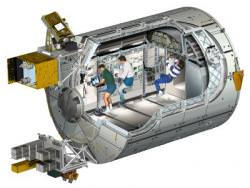For European scientists and space enthusiasts, the wait will soon be over. The Columbus module, the European Space Agency’s (ESA) major component for the International Space Station, will finally be delivered to the ISS aboard space shuttle Atlantis on STS-122. The launch is scheduled for Thursday, December 6, 2007 at 4:31 pm EST. Flying along with Columbus are two ESA astronauts, Hans Schlegel from Germany, and Leopold Eyharts from France.
The ESA considers Columbus as the most important European mission to the ISS to date and the cornerstone of Europe’s contribution to this cooperative international endeavor.
Creating a human-capable science module for a space station was first proposed by Europeans back in 1985. At that time France was considering building a mini space shuttle called Hermes to fly to a proposed space station called the Man Tended Free Flyer (MTFF) to be built by Germany and Italy. But with the postponement of MTFF in 1991 and the termination of Hermes in 1993, the planned Columbus module was left with no ride to space and nowhere to go.
When the ESA joined as an ISS partner in 1995, the Columbus science module was a logical contribution for the Europeans. The module was completed in 2000, and the original date for delivery of Columbus to orbit was 2004. But that date was pushed back following the Columbia space shuttle accident in 2003.
Columbus is 7 meters (23 feet) long and 4.5 meters (15 feet) in diameter and will hold specialized experiments for multidisciplinary research into biology, physiology, material science, fluid physics, technology, life science and education. Columbus can hold ten science racks, but will launch with only five in place, as future missions will bring more science racks on board. Additionally, there are two stands bolted to the outside of the module that can be used for research on materials and for unfiltered views of space. Columbus will be attached to the Harmony node’s starboard docking port.
Schlegel will play a key role in two of the three spacewalks or EVA (Extra-Vehicular Activity) scheduled for the mission, helping to install and power up the laboratory.
Eyharts will stay aboard the ISS for a long duration mission, replacing Dan Tani who will return to Earth on the shuttle. Eyharts will play a key part in the installation, activation and in-orbit commissioning of Columbus and its experimental facilities.
Once in orbit, Columbus will be monitored from ESA’s Columbus Control Centre located within DLR’s German Space Operations Centre in Oberpfaffenhofen, near Munich.
The American astronauts on Atlantis are Commander Stephen Frick, pilot Alan Poindexter and mission specialists Rex Walheim, Stanley Love, and Leland Melvin.
The forecast for Thursday’s launch is 80 percent “go,” decreasing to 60 percent on Friday and Saturday.
Original News Source: ESA Press Release


Thanks for keeping everyone informed. I myself will by viewing the launch from Columbus Control Center in Germany. I intend to post frequent updates to my space blog. You may want to consider it as an additional information source on Thursday.
Rainer